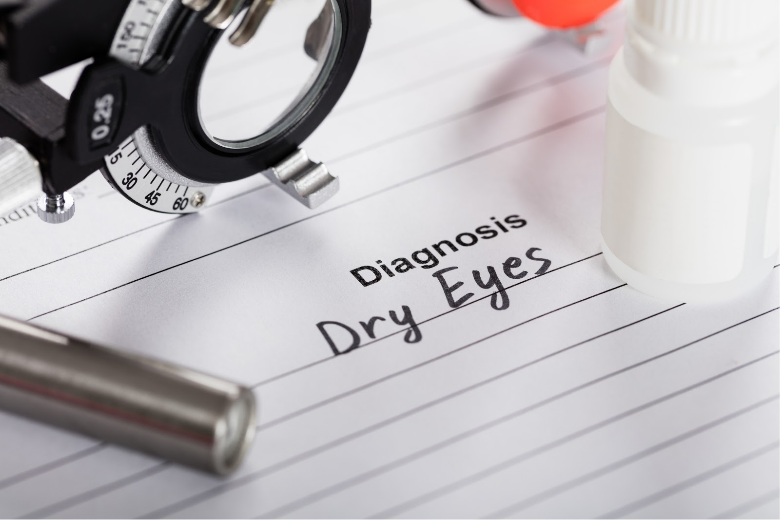
According to the National Eye Institute, an estimated 16 million Americans suffer from keratoconjunctivitis sicca—a condition more commonly known as dry eye disease (DED) or dry eye syndrome.
DED occurs when the eyes are unable to produce enough tears to continually lubricate the surface of the eye, which is important for clear vision. Common signs and symptoms include a gritty, irritated feeling as well as tired, sore, or red eyes. Patients have also reported experiencing itching, burning, aching, light sensitivity, watery eyes (from a sudden overproduction of tears), and blurred vision.
Who is most at risk for DED?
Adults over age 50, people who wear contact lenses, those taking specific medications, and those with certain medical conditions (such as Sjögren’s syndrome) are at a higher risk of developing DED; the condition also affects more women than men. In addition, outside factors such as air quality and frequent computer use may also contribute to dry eye symptoms, along with another more recent phenomenon: mask wearing.
Though necessary to help prevent the spread of COVID-19 and safeguard human health, wearing a face mask has been linked to a spike in dry eye cases. Now more than ever, having the right tools and the knowledge to effectively diagnose, treat, and manage dry eye symptoms in your patients is a necessity.
What are the two main types of DED?
There are two main types of dry eye disease, and understanding the differences between the two is the first step toward making a correct diagnosis.
Aqueous tear deficiency (ATD) dry eye occurs when the lacrimal glands cannot produce enough moisture to lubricate the front surface of the eye. In contrast, evaporative dry eye is caused by inflammation of the Meibomian glands. In both circumstances, the eyes are unable to eliminate irritants such as dust, which can lead to burning, stinging, and pain or redness.
Diagnosing DED in your patients
Despite the fact that DED is a common issue, diagnosis remains challenging for eye care professionals. There are two reasons in particular for this: 1.) Dry eye symptoms tend to vary widely from patient to patient; and 2.) There is no universal consensus for a dry eye diagnosis, meaning a generally agreed-upon set of factors does not exist.
Still, there are certain tests and procedures that can help professionals diagnose DED in their patients. These include:
- Performing a comprehensive eye exam. A thorough eye exam allows doctors to examine the full history of a patient's eye health and better understand why that individual may be suffering from dry eye problems.
- Measuring tear volume. Doctors often use the Schirmer test to measure tear production. In this procedure, blotting strips are placed beneath the lower eyelids. After five minutes, the doctor measures how much of the strip is soaked with moisture.
- Determining tear quality. Additional tests include the measurement of tear breakup time and quantification of tear components with the use of special dyes that help doctors assess the condition of a patient’s eyes.
How is DED treated?
Because diagnosing DED can be complicated, finding the ideal treatment can also be somewhat of a challenge for eye care professionals. Typically, doctors and patients will try a number of approaches to help manage dry eye symptoms before settling on the one that works best. Some of the most common treatment methods include:
- Artificial tears. These are drops and gels, either prescribed or OTC, that add moisture to the surface of the eye to help relieve dry eye symptoms. Depending on the severity of the symptoms, the doctor will determine how often they should be used.
- Eye ointments. Patients who apply eye ointment before bed to soothe and lubricate their eyes report a decrease in dry eye symptoms in the morning. (Daytime use is discouraged, as these ointments may blur vision.)
- Medication. The use of certain anti-inflammatory drugs, such as tetracycline or steroid eye drops, may provide relief for patients. Medications that increase tear production may also be prescribed.
- Surgery. In more severe cases of DED, doctors can perform surgery to insert special plugs into the lacrimal ducts to help prevent tears from draining away.
A digital imaging solution can help monitor disease progress.
With dry eye disease and other age-related eye conditions becoming more common among older patients, many doctors are utilizing cutting-edge digital imaging technology to assist with diagnosis and symptom management.
Anterior segment imaging, for example, may be used to confirm a DED diagnosis and help you more effectively monitor disease progress and safeguard your patients' vision.
Build a successful dry eye practice with Veatch.
Now more than ever, educating your patients about dry eye and developing an effective DED protocol is critical for helping them manage their dry eye symptoms. Count on Veatch Ophthalmic Instruments for the most up-to-date information, equipment, and supplies to diagnose and treat DED and ensure quality health outcomes for your dry eye patients.